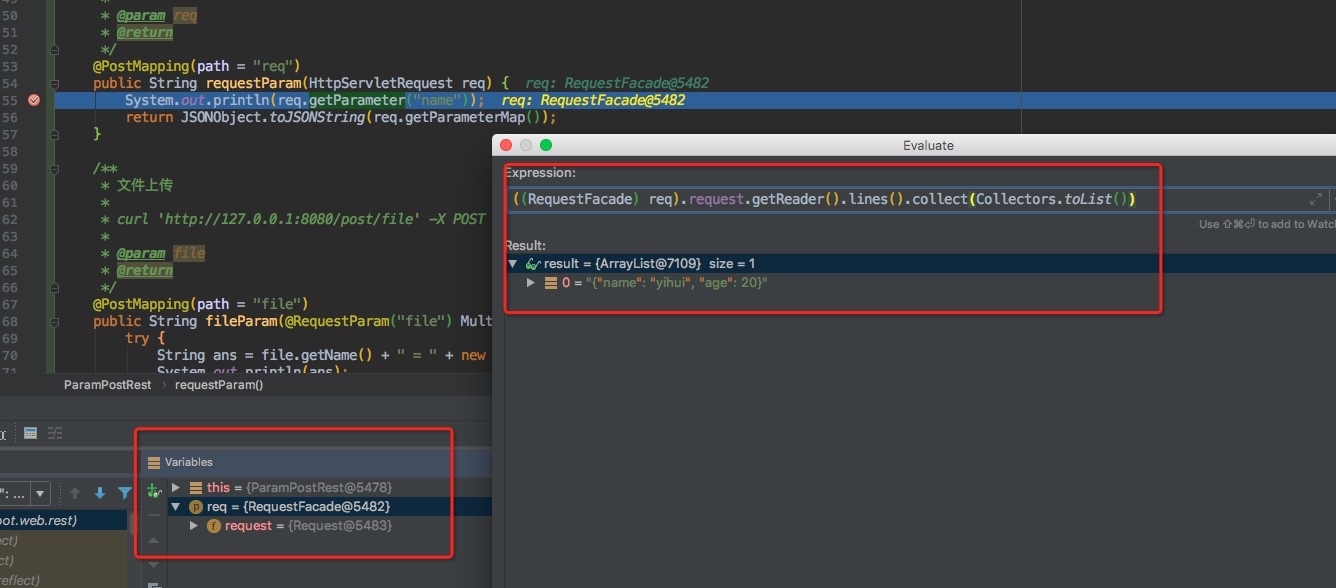您好,登錄后才能下訂單哦!
您好,登錄后才能下訂單哦!
這期內容當中小編將會給大家帶來有關如何解析Post請求參數,文章內容豐富且以專業的角度為大家分析和敘述,閱讀完這篇文章希望大家可以有所收獲。
作為一個常年提供各種Http接口的后端而言,如何獲取請求參數可以說是一項基本技能了,本篇為《190824-SpringBoot系列教程web篇之Get請求參數解析姿勢匯總》之后的第二篇,對于POST請求方式下,又可以怎樣獲取請求參數呢
本篇主要內容包括以下幾種姿勢
@RequestBody json格式
RequestEntity
MultipartFile 文件上傳
<!-- more -->
首先得搭建一個web應用才有可能繼續后續的測試,借助SpringBoot搭建一個web應用屬于比較簡單的活;
創建一個maven項目,pom文件如下
<parent> <groupId>org.springframework.boot</groupId> <artifactId>spring-boot-starter-parent</artifactId> <version>2.1.7</version> <relativePath/> <!-- lookup parent from update --> </parent> <properties> <project.build.sourceEncoding>UTF-8</project.build.sourceEncoding> <project.reporting.outputEncoding>UTF-8</project.reporting.outputEncoding> <spring-cloud.version>Finchley.RELEASE</spring-cloud.version> <java.version>1.8</java.version> </properties> <dependencies> <dependency> <groupId>org.springframework.boot</groupId> <artifactId>spring-boot-starter-web</artifactId> </dependency> </dependencies> <build> <pluginManagement> <plugins> <plugin> <groupId>org.springframework.boot</groupId> <artifactId>spring-boot-maven-plugin</artifactId> </plugin> </plugins> </pluginManagement> </build> <repositories> <repository> <id>spring-milestones</id> <name>Spring Milestones</name> <url>https://repo.spring.io/milestone</url> <snapshots> <enabled>false</enabled> </snapshots> </repository> </repositories>
添加項目啟動類Application.cass
@SpringBootApplication
public class Application {
public static void main(String[] args) {
SpringApplication.run(Application.class);
}
}在演示請求參數的解析實例中,我們使用終端的curl命令來發起http請求(主要原因是截圖上傳太麻煩,還是終端的文本輸出比較方便;缺點是不太直觀)
接下來我們正式進入參數解析的妖嬈姿勢篇,會介紹一下常見的一些case(并不能說包含了所有的使用case)
下面所有的方法都放在 ParamPostRest 這個Controller中
@RestController
@RequestMapping(path = "post")
public class ParamPostRest {
}在正式介紹之前,強烈推薦看一下《190824-SpringBoot系列教程web篇之Get請求參數解析姿勢匯總》, 因為get傳參的姿勢,在post參數解析中同樣適用,下面的內容并不會再次詳細介紹
首先看一下最基本的使用case,和get請求里的case一樣,我們先開一個接口
@PostMapping(path = "req")
public String requestParam(HttpServletRequest req) {
return JSONObject.toJSONString(req.getParameterMap());
}我們測試下兩種post請求下,會出現怎樣的結果
# 常規的表單提交方式
# content-type: application/x-www-form-urlencoded
? ~ curl 'http://127.0.0.1:8080/post/req' -X POST -d 'name=yihui&age=18'
{"name":["yihui"],"age":["18"]}%
# json傳提交
? ~ curl 'http://127.0.0.1:8080/post/req' -X POST -H 'content-type:application/json;charset:UTF-8' -d '{"name": "yihui", "age": 20}'
{}%從上面的case中可以知道,通過傳統的表達方式提交的數據時,獲取參數和get獲取參數使用姿勢一樣;然而當然傳入的是json串格式的數據時,直接通過javax.servlet.ServletRequest#getParameter獲取不到對應的參數
我們通過debug,來看一下在傳json串數據的時候,如果我們要獲取數據,可以怎么做

上面截圖演示了我們從請求的InputStream中獲取post參數;所以再實際使用的時候需要注意,流中的數據只能讀一次,讀完了就沒了; 這個和我們使用GET傳參是有很大的差別的
注意:如果您有一個打印請求參數日志的切面,在獲取post傳的參數時需要注意,是不是把流的數據讀了,導致業務中無法獲取到正確的數據!!!
上面說到傳json串數據時,后端直接通過HttpServletRequest獲取數據不太方便,那么有更優雅的使用姿勢么?下面我們看一下@RequestBody注解的使用
@Data
public class BaseReqDO implements Serializable {
private static final long serialVersionUID = 8706843673978981262L;
private String name;
private Integer age;
private List<Integer> uIds;
}
@PostMapping(path = "body")
public String bodyParam(@RequestBody BaseReqDO req) {
return req == null ? "null" : req.toString();
}只需要在參數中添加@RequestBody注解即可,然后這個接口就支持json串的POST提交了
# json串數據提交
? ~ curl 'http://127.0.0.1:8080/post/body' -X POST -H 'content-type:application/json;charset:UTF-8' -d '{"name": "yihui", "age": 20}'
BaseReqDO(name=yihui, age=20, uIds=null)%
# 表單數據提交
? ~ curl 'http://127.0.0.1:8080/post/body' -X POST -d 'name=yihui&age=20'
{"timestamp":1566987651551,"status":415,"error":"Unsupported Media Type","message":"Content type 'application/x-www-form-urlencoded;charset=UTF-8' not supported","path":"/post/body"}%說明:使用@RequestBody注解之后,可解析提交的json串;但不再支持表單提交參數方式(application/x-www-form-urlencoded)
使用RequestEntity來解析參數,可能并不太常見,它用來解析json串提交的參數也比較合適,使用姿勢也比較簡單
@PostMapping(path = "entity")
public String entityParam(RequestEntity requestEntity) {
return Objects.requireNonNull(requestEntity.getBody()).toString();
}使用case如下
# json串數據提交
? ~ curl 'http://127.0.0.1:8080/post/entity' -X POST -H 'content-type:application/json;charset:UTF-8' -d '{"name": "yihui", "age": 20}'
{name=yihui, age=20}%
# 表單數據提交不行
? ~ curl 'http://127.0.0.1:8080/post/entity' -X POST -d 'name=yihui&age=19'
{"timestamp":1566988137298,"status":415,"error":"Unsupported Media Type","message":"Content type 'application/x-www-form-urlencoded;charset=UTF-8' not supported","path":"/post/entity"}%文件上傳也是一個比較常見的,支持起來也比較簡單,有兩種方式,一個是使用MultipartHttpServletRequest參數來獲取上傳的文件;一個是借助 @RequestParam注解
private String getMsg(MultipartFile file) {
String ans = null;
try {
ans = file.getName() + " = " + new String(file.getBytes(), "UTF-8");
} catch (IOException e) {
e.printStackTrace();
return e.getMessage();
}
System.out.println(ans);
return ans;
}
/**
* 文件上傳
*
* curl 'http://127.0.0.1:8080/post/file' -X POST -F 'file=@hello.txt'
*
* @param file
* @return
*/
@PostMapping(path = "file")
public String fileParam(@RequestParam("file") MultipartFile file) {
return getMsg(file);
}
@PostMapping(path = "file2")
public String fileParam2(MultipartHttpServletRequest request) {
MultipartFile file = request.getFile("file");
return getMsg(file);
}測試case如下
# 創建一個文本文件 ? ~ vim hello.txt hello, this is yhh's spring test! # 使用curl -F 實現文件上傳,注意使用姿勢 ? ~ curl 'http://127.0.0.1:8080/post/file' -F 'file=@hello.txt' file = hello, this is yhh's spring test! ? ~ curl 'http://127.0.0.1:8080/post/file2' -F 'file=@hello.txt' file = hello, this is yhh's spring test!
上面介紹的幾種有別于GET篇中的請求姿勢,請注意GET請求參數的解析方式,在POST請求中,可能也是適用的,為什么說可能?因為在post請求中,不同的content-type,對參數的解析影響還是有的;
需要注意的是,對于傳統的表單提交(application/x-www-form-urlencoded)方式,post的參數解析依然可以使用
上述就是小編為大家分享的如何解析Post請求參數了,如果剛好有類似的疑惑,不妨參照上述分析進行理解。如果想知道更多相關知識,歡迎關注億速云行業資訊頻道。
免責聲明:本站發布的內容(圖片、視頻和文字)以原創、轉載和分享為主,文章觀點不代表本網站立場,如果涉及侵權請聯系站長郵箱:is@yisu.com進行舉報,并提供相關證據,一經查實,將立刻刪除涉嫌侵權內容。